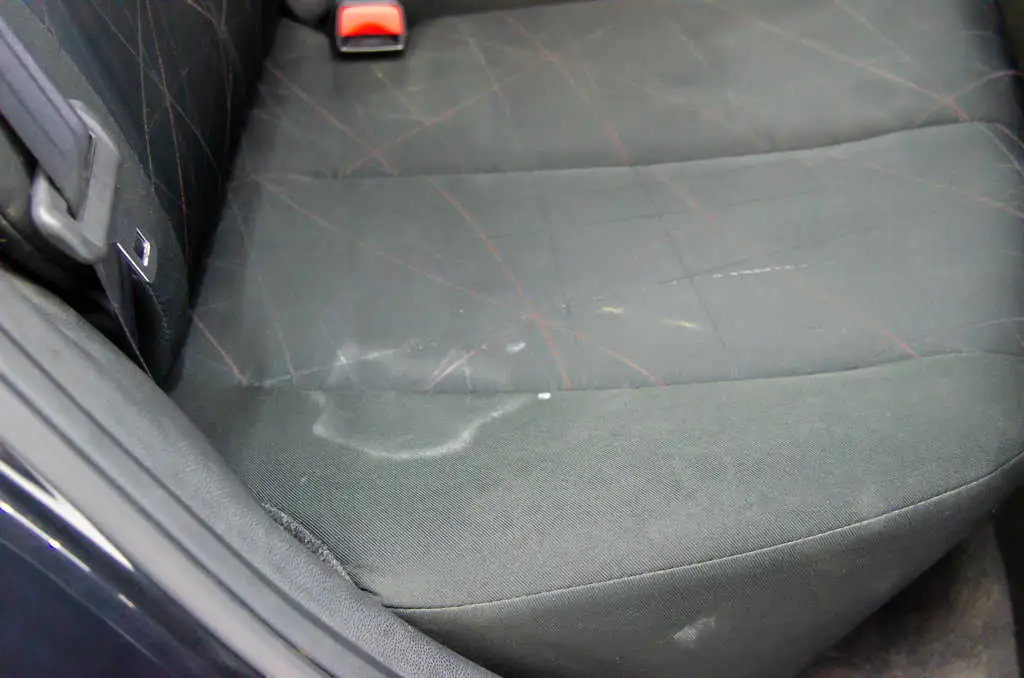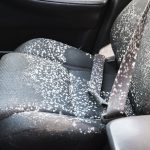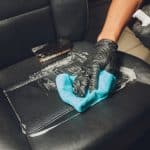If you’re someone who regularly uses sunscreen and may have spilled it on your leather car seats, or if you’ve come from a trip to the beach and the sunscreen on your skin has rubbed off on your seats, it may have left a stain. Sunscreen stains can be quite unsightly, especially on dark or gray leather. Here’s how you can remove them whether your leather is synthetic or real.
Does sunscreen stain leather?
Yes, sunscreen can indeed stain leather surfaces. Sunscreen contains ingredients such as titanium oxide and zinc oxide which can cause obvious and lasting stains on your leather seats. Plus, most sunblock leaves a greasy and shiny feel to our skin, what more for leather? You’ll notice stains from sunscreen because it will show a greasy white layer on the leather surface.
What removes sunscreen from leather?
Fortunately, if you accidentally spilled sunscreen lotion on the interior of your car or on your leather seats, there are ways you can effectively remove the stains. You can easily find cleaning solutions such as baking soda or mild soap. It still will most likely leave sunscreen residue on the surface so be sure to follow the steps below carefully.

How to get sunscreen off leather seats
Removing sunscreen stains on your leather car seats and furniture can be tedious especially if you’ve left the stain unattended for a long time. That’s why we recommend cleaning up the spillage as soon as it makes contact with a leather surface. Here are some ways you can get rid of sunscreen stains on your leather seats:
Use mild soap
This method can be used on either faux or real leather seats. Even though most car seats and leather furniture are now made from faux leather, sunscreen can still leave stains on them due to its grainy texture.
Things you will need:
- Sponge
- Mild soap or mild detergent
- Warm water
- Paper towels
- Soft cloth
- Plastic container
Steps:
- The first thing you should do is immediately remove the spilled sunblock on your leather seat. You can use a soft cloth or paper towels to do this.
- Mix warm water with mild soap in a plastic container just enough to get light soap suds.
- Soak up the solution using a sponge and form a foam lather. Gently rub it on the surface with the sunscreen stain.
- Once you’ve removed all the stains, wipe off the excess soap suds using a damp cloth.
- Finally, wipe everything off with a soft microfiber cloth.
- Apply leather conditioner to bring back the natural oils of the leather.
Use baking soda
Baking soda has been a go-to solution for people who want to remove stains and odors from any leather surface. This is because it has great absorbing properties and it doesn’t do any damage compared to other methods that use stronger cleaning solutions.
Things you will need:
- Damp cloth
- Dry microfiber cloth
- Baking soda
Steps:
- Blot the sunscreen on the leather surface using a soft dry cloth. Avoid rubbing it as it will only spread and make the sunscreen sink deeper into the leather fibers.
- Sprinkle baking soda on the surface and make sure that the area is covered thoroughly.
- Let the baking soda sit on the stained leather surface for about 12 hours to give it some time to properly absorb the moisture and remove any sticky residue.
- After 12 hours, you’ll notice that the baking soda has turned yellowish. This indicates that it has done its job absorbing the sunscreen from the leather fibers.
- Blot away the baking soda using a damp cloth.
- Wipe away any excess product and moisture using a soft cloth and condition your leather car seats.
Tips and extra information:
- If you don’t have baking soda, you can use cornstarch as an alternative. It works just as well as baking soda.
Use leather degreaser
Degreasers are great at removing that greasy feel left by your sunblock. However, you have to make sure that the degreaser is leather-friendly to avoid damage. There are leather degreaser products on the market that you can find for a low price and here’s how to apply them:
Things you will need:
- Leather degreaser
- Paper towels
- Paintbrush
- Damp cloth
- Microfiber cloth
- Leather conditioner
- Powerful Citrus Cleaning Formula: Packed with d'Limonene terpenes, 3D Orange Degreaser cuts through...
- Multi-Surface Safe Performance: This water-based degreaser is safe to use on vinyl, plastic, cloth,...
- No Film, No Residue, No Stains: Wipe away oil and grime without sticky leftovers or streaks. 3D...
Steps:
- As always, blot out the sunscreen from the leather surface and remove as much as you can without rubbing using paper towels.
- Using a paintbrush, apply the leather degreaser on the stain and wait until it dries up.
- The leather degreaser will do its job and absorb the greasy feel and stains left by the sunblock.
- Once the degreaser has dried up, it will feel powdery to your touch and you can then easily vacuum it off.
- Clean the area using a damp cloth and follow it up with a dry microfiber cloth.
- Repeat the process until you’re satisfied and apply leather conditioner once you’re done.
Tips and extra information:
- Bi-cast leather can have adverse reactions to degreasers sometimes so make sure you know the type of leather you have and apply the product first on a hidden spot to check to see if it has bad reactions.
White Vinegar
Another famous leather cleaning solution that can be easily found at home is white vinegar. White vinegar contains mild acid that can effectively remove oil-based substances like sunblock. However, you should do this method quickly as the acid can dry out the leather seats if left there for a long time.
Things you will need:
- White vinegar
- Plastic container
- Sponge
- Soft cloth or clean cloth
- Leather conditioner
- Paper towels
Steps:
- Remove the sunblock using paper towels and the blotting method.
- Mix white vinegar with lukewarm water using a 1:1 ratio.
- Use a sponge or soft cloth to lightly scrub the area with sunscreen stain.
- Be sure to do this quickly since white vinegar can be drying for leather surfaces.
- Wipe away the excess of the cleaning solution using a dry microfiber towel and apply leather conditioner.
Why sunscreen is bad for your leather Car seats
If you’re planning to go on a vacation or a trip to the beach to get a sun tan, you probably know why it’s still important to apply sunblock. However, chances are you’d get some sunscreen onto your car’s interior and this is and this is bad news for your leather seats. Here are some reasons why you should avoid getting sunscreen on leather surfaces:
Sunscreen is made to endure
Sunscreen, especially higher SPF levels are made to create a thick, protective layer over your skin that limits the amount of UV radiation that goes through. This means that it is also formulated to be difficult to remove as it has to endure physical activity, bathing, and lying down on various surfaces.
When it gets on your leather seats, these properties stay true. It sticks to the surface well and resists any rubbing and water you try to use to remove it. This is why it takes specific approaches to remove it.
Sunscreen can destroy faux leather
Some sunscreens that feature high water resistance may use petroleum-based grease. This is very bad for faux leather as it can chemically interact with the synthetic material and weaken it. The plastic used in the faux leather may also be petroleum-based and it may cause your faux leather to peel and crack sooner than its expected lifespan.
Most car seats are made of faux leather, and if you aren’t sure what type of leather your car seats are made of, we suggest removing them as soon as you can.
Sunscreen can block your leather’s pores
Sunscreen’s coating capabilities can interfere with the breathability of the leather. It may not affect your own skin as much, but it can affect the leather pores negatively. This may not be an issue when it is in a small area, but it can lead to a build-up of moisture in that area.
On car seats, this can be a problem as your sweat won’t be able to evaporate out of the leather and it may cause molding.
Sunscreen can make leather sticky
Sunscreen usually uses a type of grease as a base. This is what makes it water-resistant and difficult to remove. Just like how many people don’t like the feeling of sunscreen on their skin, it can also give the same amount of discomfort when it’s on your leather items.
Touching it can feel very sticky and greasy, yet it never goes away no matter how much you rub on it because of the ingredients in the sunscreen.
Sunscreen stains become more difficult to remove the longer it stays
Sunscreen can seep into the leather the longer it stays on it. If you can wipe it off with a cleaning wipe as soon as you can, you should do so. As mentioned earlier, avoid using too much pressure when removing it as you might end up letting more of it absorb into the leather.
Conclusion
It’s not the end of the world if there are sunscreen stains on any of your leather goods or leather car seats. Although the longer you leave them on, the more difficult it will be to deal with them. It’s always best to have leather-safe cleaning wipes in your car or in your bag ready at all times in case of any emergencies like those. Getting to them immediately may prevent the stains completely or at the very least, make the stains easier to remove.
FAQ
Does rubbing alcohol remove sunscreen stains?
Rubbing alcohol isn’t particularly great for leather as it can remove its protective coating. However, it is able to remove sunscreen stains. We would recommend this if it’s the only thing you have on you as it is best to remove the sunscreen stains as soon as you can. You can always recondition your leather later when you are able, just make sure not to forget as unconditioned leather can be damaged more easily.
Does acetone remove sunscreen?
Acetone is certainly able to remove sunscreen from your leather goods. However, we highly recommend not using acetone in any circumstance, especially in your car. When the acetone evaporates, it will evaporate in your car and acetone fumes are very dangerous.
Acetone can also weaken faux leather and discolor it easily, which will be worse than sunscreen stains. Acetone will also remove the dye on real leather, causing faded colors where the acetone was applied and it will be more difficult and costly to repair that over the sunscreen stains.







